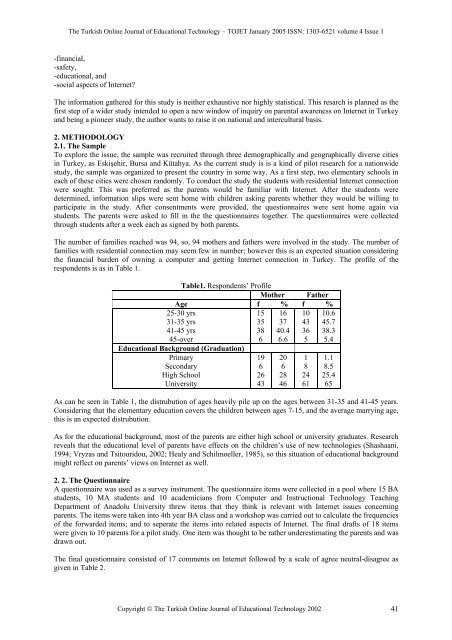Age - TOJET the Turkish online journal of educational technology
Age - TOJET the Turkish online journal of educational technology
Age - TOJET the Turkish online journal of educational technology
You also want an ePaper? Increase the reach of your titles
YUMPU automatically turns print PDFs into web optimized ePapers that Google loves.
The <strong>Turkish</strong> Online Journal <strong>of</strong> Educational Technology – <strong>TOJET</strong> January 2005 ISSN: 1303-6521 volume 4 Issue 1<br />
-financial,<br />
-safety,<br />
-<strong>educational</strong>, and<br />
-social aspects <strong>of</strong> Internet?<br />
The information ga<strong>the</strong>red for this study is nei<strong>the</strong>r exhaustive nor highly statistical. This resarch is planned as <strong>the</strong><br />
first step <strong>of</strong> a wider study intended to open a new window <strong>of</strong> inquiry on parental awareness on Internet in Turkey<br />
and being a pioneer study, <strong>the</strong> author wants to raise it on national and intercultural basis.<br />
2. METHODOLOGY<br />
2.1. The Sample<br />
To explore <strong>the</strong> issue, <strong>the</strong> sample was recruited through three demographically and geographically diverse cities<br />
in Turkey, as Eskişehir, Bursa and Kütahya. As <strong>the</strong> current study is is a kind <strong>of</strong> pilot research for a nationwide<br />
study, <strong>the</strong> sample was organized to present <strong>the</strong> country in some way. As a first step, two elementary schools in<br />
each <strong>of</strong> <strong>the</strong>se cities were chosen randomly. To conduct <strong>the</strong> study <strong>the</strong> students with residential Internet connection<br />
were sought. This was preferred as <strong>the</strong> parents would be familiar with Internet. After <strong>the</strong> students were<br />
determined, information slips were sent home with children asking parents whe<strong>the</strong>r <strong>the</strong>y would be willing to<br />
participate in <strong>the</strong> study. After consentments were provided, <strong>the</strong> questionnaires were sent home again via<br />
students. The parents were asked to fill in <strong>the</strong> <strong>the</strong> questionnaires toge<strong>the</strong>r. The questionnaires were collected<br />
through students after a week each as signed by both parents.<br />
The number <strong>of</strong> families reached was 94, so, 94 mo<strong>the</strong>rs and fa<strong>the</strong>rs were involved in <strong>the</strong> study. The number <strong>of</strong><br />
families with residential connection may seem few in number; however this is an expected situation considering<br />
<strong>the</strong> financial burden <strong>of</strong> owning a computer and getting Internet connection in Turkey. The pr<strong>of</strong>ile <strong>of</strong> <strong>the</strong><br />
respondents is as in Table 1.<br />
Table1. Respondents’ Pr<strong>of</strong>ile<br />
Mo<strong>the</strong>r Fa<strong>the</strong>r<br />
<strong>Age</strong> f % f %<br />
25-30 yrs<br />
31-35 yrs<br />
41-45 yrs<br />
45-over<br />
Educational Background (Graduation)<br />
Primary<br />
Secondary<br />
High School<br />
University<br />
As can be seen in Table 1, <strong>the</strong> distrubution <strong>of</strong> ages heavily pile up on <strong>the</strong> ages between 31-35 and 41-45 years.<br />
Considering that <strong>the</strong> elementary education covers <strong>the</strong> children between ages 7-15, and <strong>the</strong> average marrying age,<br />
this is an expected distrubution.<br />
As for <strong>the</strong> <strong>educational</strong> background, most <strong>of</strong> <strong>the</strong> parents are ei<strong>the</strong>r high school or university graduates. Research<br />
reveals that <strong>the</strong> <strong>educational</strong> level <strong>of</strong> parents have effects on <strong>the</strong> children’s use <strong>of</strong> new technologies (Shashaani,<br />
1994; Vryzas and Tsitouridou, 2002; Healy and Schilmoeller, 1985), so this situation <strong>of</strong> <strong>educational</strong> background<br />
might reflect on parents’ views on Internet as well.<br />
2. 2. The Questionnaire<br />
A questionnaire was used as a survey instrument. The questionnaire items were collected in a pool where 15 BA<br />
students, 10 MA students and 10 academicians from Computer and Instructional Technology Teaching<br />
Department <strong>of</strong> Anadolu University threw items that <strong>the</strong>y think is relevant with Internet issues concerning<br />
parents. The items were taken into 4th year BA class and a workshop was carried out to calculate <strong>the</strong> frequencies<br />
<strong>of</strong> <strong>the</strong> forwarded items; and to seperate <strong>the</strong> items into related aspects <strong>of</strong> Internet. The final drafts <strong>of</strong> 18 items<br />
were given to 10 parents for a pilot study. One item was thought to be ra<strong>the</strong>r underestimating <strong>the</strong> parents and was<br />
drawn out.<br />
The final questionnaire consisted <strong>of</strong> 17 comments on Internet followed by a scale <strong>of</strong> agree neutral-disagree as<br />
given in Table 2.<br />
15<br />
35<br />
38<br />
6<br />
19<br />
6<br />
26<br />
43<br />
16<br />
37<br />
40.4<br />
6.6<br />
Copyright © The <strong>Turkish</strong> Online Journal <strong>of</strong> Educational Technology 2002 41<br />
20<br />
6<br />
28<br />
46<br />
10<br />
43<br />
36<br />
5<br />
1<br />
8<br />
24<br />
61<br />
10.6<br />
45.7<br />
38.3<br />
5.4<br />
1.1<br />
8.5<br />
25.4<br />
65
















